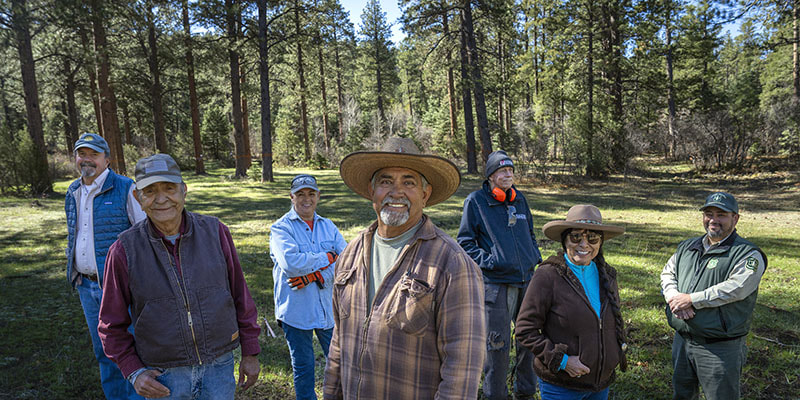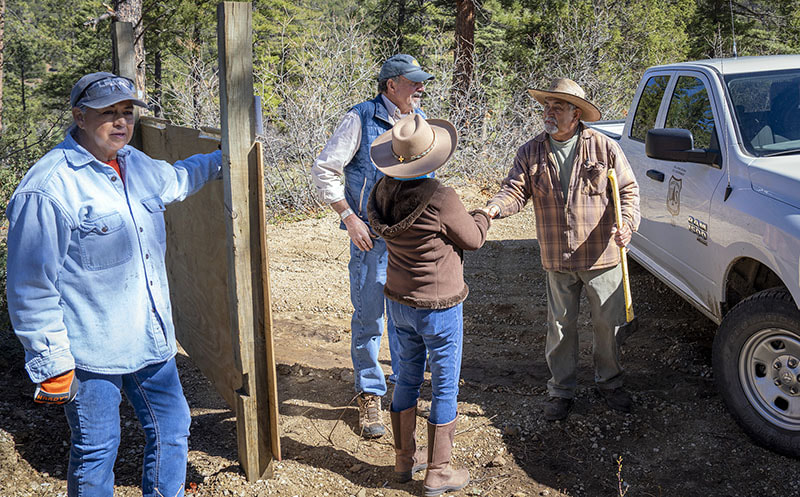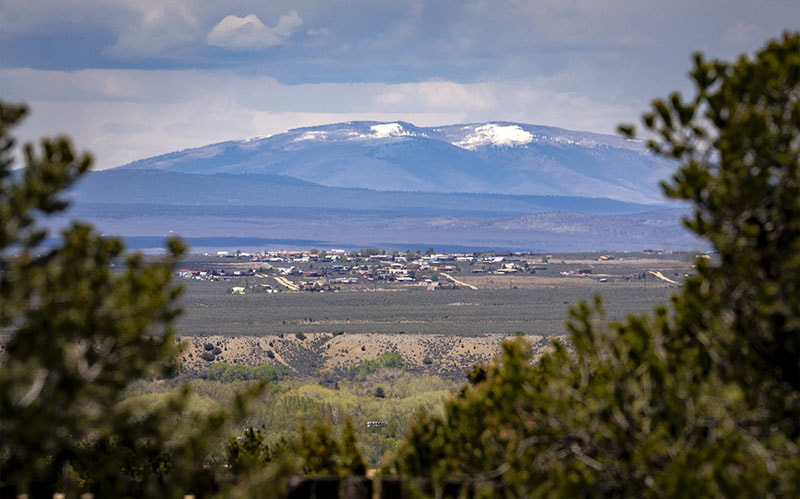|
Wildfire risk reduction restores water—Co-stewardship is the key Tracy Farley and Zachary Behrens Office of Communication and Carson National Forest  The Rio Fernando Collaborative has partnered with Taos County and the Forest Service to reduce wildfire risk and improve water availability in the Taos, New Mexico region. From left to right – Wayne Rutherford, Joe Fernandez, MaryAnn Fernandez, Vicente Fernandez, Ed Bell, Patricia Martinez Rutherford and Michael Lujan. (USDA/Forest Service photo by Preston Keres) I’m the project overseer,” said Mayordomo Vicente Fernandez humbly when asked specifically about his mayordomo title. Vicente is the community manager of a 71-acre parcel in the Carson National Forest near Taos, New Mexico, where he and a group of volunteers are reducing hazardous fuels while improving water quality and quantity. Like his distinctive title, the project itself is unique. It’s called the Rio Don Fernando Cañon Leñero Project, which has been in existence for centuries, if not longer. It’s all about the approach. The project is modeled on acequias, pronounced “uh·say·key-ah,” which are communally managed irrigation ditches. Spanish settlers brought the tradition into the area in the late 1500s and adopted enhancements influenced by the local Indigenous peoples from the local Pueblo tribes, who were already using irrigation methods to farm the arid land. Acequias are legally recognized subdivisions and are as much alive today as they were centuries ago. Now, an elected mayordomo oversees annual maintenance and water allocation. The Rio Don Fernando project takes the acequia model and applies it upstream to a forest thinning unit. “Our watershed is our life. This project, our watershed here is so important because a lot of people's lives depend on it,” said Vicente. “We are the smallest watershed in the valley and it's very, very important to us and what we're doing here, thinning out the forest.” The volunteers, or leñeros, which means “woodcutters” in Spanish, work in Vicente’s mayordomo unit, which is located in the U.S. Department of Agriculture’s Forest Service’s Wildfire Crisis Strategy’s Enchanted Circle Landscape. They thin trees under a prescription to reduce the threat of wildfire and make more ground moisture available. In the short term, the leñeros keep the thinned timber as personal fuelwood for cooking, or to heat their homes in the winter, while also earning a modest stipend. Long term, the leñeros’ thinning work improves the forest and watershed health that ultimately benefits their farms downstream. Their work also ensures they can carry on their traditional ways of life for generations. “Having local community members, or government leaders such as our acequia mayordomos, managing projects like this, gives them the stewardship of that ground most critical to their values,” said Camino Real District Ranger Michael Lujan. “This type of stewardship by the community is going to help to keep that portion of the watershed sustainable for years to come, regardless of changes to mission or funding.” “It just makes sense to have them steward that piece of ground that's going to connect that water to the communities like it has for the last 200 or 300 years, into time immemorial,” Lujan added.  Carson National Forest Enchanted Circle Landscape shows the synergy of collaboration with a multitude of partners to reduce wildfire risk and provide life-giving water coming from snowpack on the forest to families, schools and communities with food, water, fuelwood. (USDA Forest Service photos by Preston Keres) Snowpack feeds water into the acequias, which frequently begin on the national forest. A gate or a diversion directs the flow of water in the irrigation ditch. Many ditches branch off into different areas of the community, and each one may have a mayordomo that manages each one. It eventually becomes a neighborhood or community acequia. Many acequias provide a primary source of water for farming and ranching, and more than 700 acequias in northern New Mexico continue to function. In New Mexico, by state statute, acequias are registered bodies and as such must have three commissioners and a mayordomo. This Rio Don Fernando project is part of the larger Pueblo Ridge Project, which is just under 10,000 acres of restoration work for watershed improvement, forest health management and ultimately reducing wildfire risk. “This is really exciting because the Pueblo Ridge Project is critical to protecting tribal lands and providing clean water. The water that you see running down the canyon and into the community of Taos, is critical to the lifestyle and the traditional uses here,” said Lujan. Vicente and his leñeros work directly with the Forest Service to manage this portion of the forest.
“The collaboration between the executive, the leñero, and the Forest Service is there. It’s tight,” said Vicente. “We couldn't have started this program without their help. We have had their foresters out here. They've helped me walk the whole perimeter of the area. We've marked the trees. As you can see, they’re all marked and it's a good education for me that I can give to my leñeros.” “We were born in these mountains. We were raised in these mountains. And we want to keep these mountains not just for us, but for our grandchildren and for people to enjoy,” Vicente said, “Because when you look at it, it's all our responsibility, not just the Forest Service. It's the community’s. It's our responsibility to take care of this.” Definitions
This is the first of two stories featuring the Carson National Forest’s Enchanted Circle Landscape, part of the USDA Forest Service’s Wildfire Crisis Strategy, which focuses on water restoration and wildfire risk reduction. Read Part next week
2 Comments
ROGER J. CAOUETTE
8/16/2024 08:40:42 pm
THANKS FOR THE CLEAR AND CONCISE EXPLANATION .
Reply
Donna Humphreys
8/23/2024 10:57:37 am
So happy to see this natural way of clearing forest floor porentialvl wildfire fuel instrad of destructve "controlled" burns.
Reply
Your comment will be posted after it is approved.
Leave a Reply. |
Submit your ideas for local feature articles
Profiles Gardening Recipes Observations Birding Essays Hiking AuthorsYou! Archives
October 2025
Categories
All
|


 RSS Feed
RSS Feed